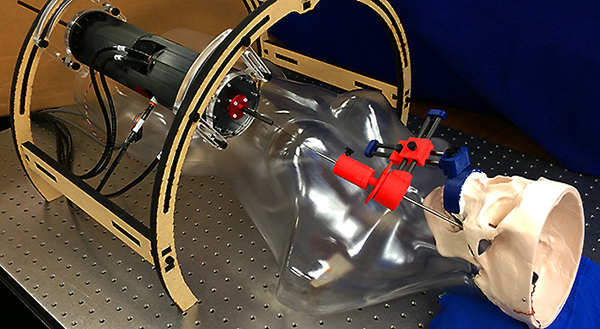
Patient mockup of surgical robot designed to treat epilepsy by entering the brain through the cheek. (Laboratory for the Design and Control of Energetic Systems / Vanderbilt)
 Cut-away view of the robotic platform reveals how much of the device can be made by 3-D printing. (Laboratory for the Design and Control of Energetic Systems / Vanderbilt)
Cut-away view of the robotic platform reveals how much of the device can be made by 3-D printing. (Laboratory for the Design and Control of Energetic Systems / Vanderbilt)
People with certain types of epilepsy these days have the option of having a part of their hippocampus ablated, a procedure that requires drilling a hole in the scalp, reaching the bottom of the brain, and using a probe to remove the tissue that generates stray electric signals. This is brain surgery both literally and figuratively, that requires steady hands, a full understanding of the anatomy of the head, and being able to work inside an MRI scanner. Researchers at Vanderbilt University have been building a robot to access the hippocampus more directly, via the cheek, and make the procedure less invasive and easier to perform.
Because there’s no straight shot to the hippocampus even with an approach from below, the technique requires using a steerable needle to navigate to the right spot without damaging important tissue on the way. The needle is made out of nitinol, a popular shape-memory allow used in stents and other medical devices in part because it is non-ferromagnetic. The needle consists of concentric tubes powered by compressed air, some of which are curved, which extend independently to create a path that extends to the target within the brain. The needle can be advanced a millimeter at a time to make sure it’s following the correct path and its exact position visualized under MRI.
The next step is to begin testing the robot on cadavers and eventually move to clinical trials, with the researchers expecting a final market-ready product to be available only within a decade.
Vanderbilt: Brain surgery through the cheek
